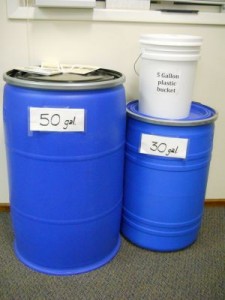 Evacuation support sites help provide shelter, water and food for thousands in Cannon Beach
Evacuation support sites help provide shelter, water and food for thousands in Cannon Beach
Thanks to an innovative pilot project sponsored by the city of Cannon Beach, North Coast residents have some help in place today in case of an earthquake or tsunami tomorrow.
Three evacuation support sites will help provide shelter, water and food for the thousands of people in the area that are expected to be affected by a Cascadia Subduction Zone event. At the first site, two 20-foot shipping containers were placed on a concrete pad; each one can benefit about 700 people for at least four days. With the recent addition of two more sites, Cannon Beach can provide sustainable support for up to 4,200 survivors.
“The success of the Emergency Preparedness program in Cannon Beach is a direct result of citizen involvement and city council commitment to supporting the program,” says Public Works Director Dan Grassick.
Combating fear
Public reaction to this natural disaster planning has been very positive. “The goal is to take practical steps to increase the odds of surviving those events as opposed to living in fear of them happening,” Grassick says. Emergency Preparedness Committee members and city staff continue with community education efforts for both local and part-time residents. Since the inception of the program in early 2012, between 15 and 20 additional barrels are added to the cache sites each year.
Each shipping container is loaded with three different types of supplies: family cache containers; medical, administrative, and support equipment; and tourist, employee and visitor kits. City emergency management personnel will open the containers in case of an emergency.
Coastal families are invited to obtain storage containers at cost from the city and fill them with their own supplies, to be stored at the evacuation site nearest to their home.
Families can choose from 55-gallon drums, 30-gallon barrels or 5-gallon buckets. The city also charges an annual maintenance fee based on the size of the container. The cost for a 55-gallon plastic barrel, for instance, is $57.90, plus $55 for the annual maintenance fee.
 Packing workshops
Packing workshops
Cannon Beach offers container packing workshops and a written guide to filling the caches, with community priorities identified as shelter first, water second and food last. The shipping containers are opened for three days every spring and fall to enable families to restock their supplies, and the city plans to make the openings a community gala that will include disaster awareness training, education and tsunami information.
Because tourists could make up the largest population segment at certain times of the year, Cannon Beach developed its innovative employee and visitor kit, consisting of a shelter system (poncho, space blanket, tube tent), water and food for 500 survivors.
The idea is catching on: Arcadia Beach has established its own program directly patterned on the Cannon Beach model; Arch Cape is launching its own emergency cache project; and Bandon is looking into an emergency storage system for businesses and community members.
“The key to the success of the Cannon Beach program is the folks that have stepped up,” Grassick says. “When you have people that actually live in the high-risk area, it’s real and they have a stake in it.”
Article reprinted with permission from Community Vitality Publication, Spring 2014, © 2014 The Ford Family Foundation. For the full Community Vitality edition of ”The Time to Prepare”, visit http://www.community-vitality.org/Spring2014TimeToPrepare.html



